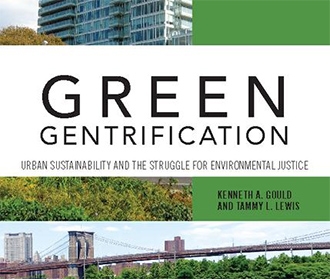

Cases of green gentrification in New York City are analyzed in a book by CUNY professors (image: release)
Cases of green gentrification in New York City are analyzed in a book by CUNY professors.
By Maria Fernanda Ziegler, in New York | Agência FAPESP – The waters of the Gowanus Canal in Brooklyn, New York, continue to have a foul smell, although the problem used to be much worse. They are the remnants of years of industrial pollution and untreated sewage discharge. The site, which was mainly factories in the 18th and 19th centuries, has undergone a federally-funded revitalization effort in recent years. New green areas were installed and services-only businesses arrived in the neighborhood. The price of residential real estate also increased, which ended up driving out some long-time residents.
The recent history of the Gowanus Canal has been repeated in other neighboring areas in New York as well as in cities around the world. According to Tammy Lewis, a professor of Sociology and Environmental and Earth Sciences at the City University of New York (CUNY), initiatives like these, although positive for the environment, tend to increase inequality and thus undermine the social pillar, one of the three pillars of sustainable development (the others being the economic and the environmental pillars).
“The idea consists of appropriating damaged environmental resources, restoring them, developing them and selling them to what we call the sustainability class. What we see is that the phenomenon is happening all over the world,” said Lewis, during a presentation at FAPESP Week New York.
The meeting, held at CUNY November 26-28, 2018, involved Brazilian and U.S. researchers with the aim of strengthening research partnerships.
Lewis is one of the authors of the recently published book, “Green Gentrification: Urban sustainability and the struggle for environmental justice,” which studied five areas that underwent green gentrification.
“Environmental recovery initiatives are always positive, but they need to be considered in a more comprehensive way. They improve the environmental conditions of the neighborhood, but generate green gentrification, which is extremely negative,” she said.
Lewis points out that the biggest problem is the change in residents. “The site starts to attract wealthy white migrants and the black working class is forced out because of increasing property prices. Without the intervention of equity-oriented public policies, negatively redistributed actions of green urbanism are bad for the world’s major cities,” she said.
The researcher says that unlike what we hear, the results of environmental injustice can be avoided. “Green policy initiatives need to be linked to fair housing policies,” she said.
Cities as part of the climate issue
In 2012, before the process of green gentrification began on the Gowanus Canal, Hurricane Sandy devastated the region. The water level of the canal rose because of the strong rain from Sandy and the polluted water mixed with untreated sewage.
Yet there has still not been a sufficient structure installed to mitigate the problem. “The unfortunate irony is that when the canal flooded, it was the black community that was affected. Now, when the next extreme phenomenon like Sandy comes along, it will be the sustainability class that will be affected,” said Lewis.
William Solecki, founding director of the Institute for Sustainable Cities at CUNY, says that for the first time, cities are becoming participants in the global response to climate change. “We recognize the we live in an urbanized world and that actions have to come from the cities,” Solocki said during his own presentation at FAPESP Week.
“But what happens when we reach the resilience limit? Build stronger buildings? There’s a limit. Cities, however, will have to not just adapt, but also mitigate the issues,” he said.
Solecki said that the consequences of Hurricane Sandy are still felt in New York City today. The researcher believes that the extreme event has served as a turning point, causing people to notice the need for adaptation plans. “We need to think about what cities can do to promote transformative actions,” he said.
Republish
The Agency FAPESP licenses news via Creative Commons (CC-BY-NC-ND) so that they can be republished free of charge and in a simple way by other digital or printed vehicles. Agência FAPESP must be credited as the source of the content being republished and the name of the reporter (if any) must be attributed. Using the HMTL button below allows compliance with these rules, detailed in Digital Republishing Policy FAPESP.





